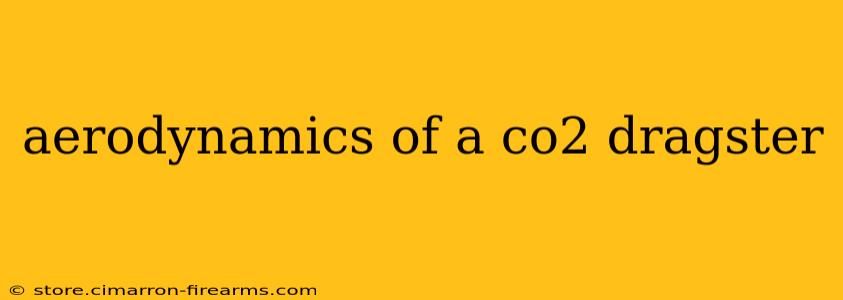The thrill of watching a CO2 dragster accelerate down a track is undeniable. These miniature marvels of engineering pack a surprising amount of speed into a compact design, and a significant portion of their performance hinges on clever aerodynamic design. This post will delve into the crucial aerodynamic principles that govern a CO2 dragster's performance, exploring how even subtle design choices can dramatically impact its top speed and overall efficiency.
Understanding the Forces at Play
A CO2 dragster, like any vehicle, faces several aerodynamic forces:
-
Drag: This is the resistance a vehicle experiences as it moves through the air. It's the primary force working against the dragster's acceleration and top speed. Drag is influenced by the dragster's shape, surface area, and velocity. A streamlined body minimizes drag, allowing for higher speeds.
-
Lift: While not as significant as drag in a CO2 dragster, lift is the upward force generated by the airflow over the body. Excessive lift can cause instability and reduce traction, especially at higher speeds. Careful design can minimize lift and ensure the dragster remains firmly planted on the track.
-
Downforce: Unlike lift, downforce pushes the dragster towards the track. While not typically a primary focus in CO2 dragster design (due to their low speeds compared to Formula 1 cars, for example), strategically placed elements can slightly increase downforce, improving traction and stability.
Key Aerodynamic Design Elements
Several design features significantly affect a CO2 dragster's aerodynamics:
1. Body Shape: Streamlining for Minimal Drag
The most crucial aspect is the body's shape. A streamlined, teardrop-like shape minimizes air resistance. Sharp edges and protruding features create turbulence and increase drag. The ideal shape smoothly transitions the airflow around the body, reducing separation and minimizing the wake behind the vehicle. Think of the shape of a bullet – it's designed for minimal air resistance for maximum penetration. The same principle applies to a CO2 dragster.
2. Surface Finish: Smoothness Matters
A smooth surface minimizes friction between the air and the dragster's body. Even small imperfections can significantly increase drag. A polished surface offers the least resistance.
3. Wheel Fairings: Reducing Wheel Drag
The wheels contribute significantly to overall drag. Wheel fairings—streamlined covers around the wheels—reduce the drag caused by the rotating wheels and the disruption of the airflow around them. This is a crucial design consideration, offering a noticeable improvement in speed.
4. Spoiler and Wing Design (Advanced Considerations):
While not as common in basic CO2 dragster designs, strategically placed spoilers and wings can generate downforce, but careful consideration is necessary. Too much downforce can significantly increase drag and negate the benefits. This is a more advanced area of aerodynamic optimization, usually reserved for more sophisticated designs aimed at maximizing performance at higher speeds.
Optimizing Aerodynamics for Maximum Performance
Optimizing a CO2 dragster's aerodynamics involves a combination of careful design and experimentation. Here are some practical tips:
-
Computational Fluid Dynamics (CFD) Simulation (Advanced): For serious competitors, CFD software can model airflow around the design, allowing for virtual testing and optimization before building a physical model.
-
Wind Tunnel Testing (Advanced): While less accessible to most, wind tunnel testing provides accurate data on aerodynamic performance, allowing for precise adjustments and improvements.
-
Iterative Design Process: Start with a basic streamlined body and then iteratively test and refine the design, making small changes and measuring the impact on speed.
Conclusion: The Aerodynamic Edge
The aerodynamics of a CO2 dragster are a critical factor in its overall performance. By understanding the forces at play and employing clever design elements like streamlining and wheel fairings, builders can significantly improve their dragster's speed and efficiency. The pursuit of aerodynamic perfection is an ongoing process of experimentation and refinement, driving innovation and the quest for the ultimate winning design.

